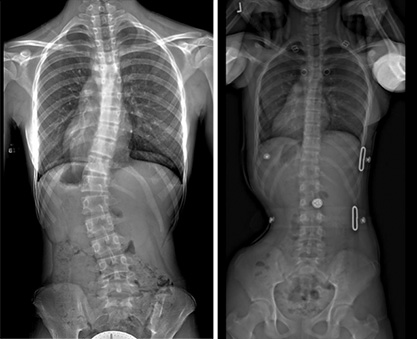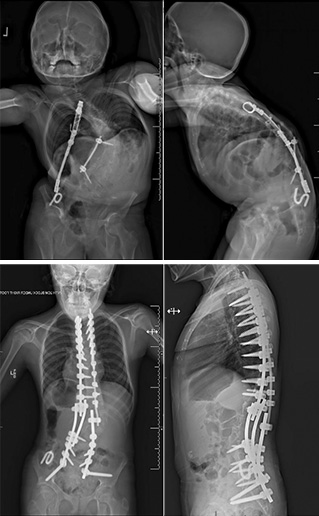Pediatric orthopedic surgeons at NewYork-Presbyterian Morgan Stanley Children’s Hospital and NewYork-Presbyterian Och Spine Hospital continue to lead national efforts to improve treatment for patients with scoliosis. Two seminal articles published in the Journal of Spine Deformity highlight this work, one developing best practice guidelines for conservative care of patients with adolescent idiopathic scoliosis (AIS) and the other developing guidelines to most safely navigate “high-risk” spine surgery.
Identifying Best Practices for Bracing
Under the leadership of the Division of Pediatric Orthopedics at NewYork-Presbyterian Morgan Stanley Children’s Hospital and Columbia, a coalition of pediatric spine surgeons and related experts from across the country and around the world took on the task of developing standards of practice for bracing in AIS.

Three-dimensional correction in modern 3D brace affects bracing success
With bracing as the foundation of nonoperative treatment for AIS to reduce curve progression and the need for surgery, significant practice variability of its use prompted a call for establishing evidence-based guidelines that can maximize outcomes in patient care. Utilizing formal consensus building techniques, a multidisciplinary group of some 40 surgeons, physiatrists, physical therapists, orthotists, and research scientists participated in the Delphi process that targeted areas of variability in brace treatment previously identified by the group. Topics of focus included:
- Bracing goals
- Indications for starting and discontinuing bracing
- Brace types and brace prescription
- Radiographs
- Physical activities
- Physiotherapeutic scoliosis-specific exercises
The final best practice recommendations – which achieved 80 percent consensus in order to be included – contained 67 items across 10 domains of brace treatment and were published in the August 2020 issue of Spine Deformity.
Making Complex Spinal Deformity Surgery Safer
Led by Michael G. Vitale, MD, and Lawrence G. Lenke, MD, in the Department of Orthopedic Surgery at Columbia and NewYork-Presbyterian Och Spine Hospital and a group of expert spine surgeons and researchers from across the world collaborated to define the parameters that constitute “high-risk” spinal deformity surgery and identify preventative strategies to minimize the risk of neurological events during these procedures.

Revision of “failed growth friendly surgery” performed abroad for early onset scoliosis in high-risk patient
Neurological deficits following spine surgery can profoundly impact a patient’s quality of life. It is crucial to respond appropriately to intraoperative neuromonitoring (IONM) events, as they provide the surgical team a window in which corrective measures can be performed to reverse the inciting factors and reduce the risk of postoperative deficits.
Although this team at Columbia has previously created a consensus-based checklist to prepare for and respond to IONM events for “low-risk” spine surgeries, they recognized that this checklist may not be exhaustive and nuanced enough for “high-risk” surgeries.
Utilizing formal consensus building techniques, a group of 15 expert spine surgeons participated in a series of discussions and surveys to determine factors that constitute “high-risk” spinal deformity, as well as identify strategies to reduce the risk of neurological deficits for these cases. Topics of focus included:
- Risk factors associated with neurological deficits: Patient factors, curve and spinal cord factors, and surgical factors
- Strategies used to prevent neurological deficits in the high-risk setting
The final best practice guidelines were organized into two checklists for clinical use. The first checklist consisted of 22 determinants of high risk – 8 patient factors, 8 curve and spinal cord factors, and 6 surgical factors. The second checklist consisted of 21 preventative strategies – 4 preoperative, 14 intraoperative, and 3 postoperative.
These checklists can be used by surgeons and clinicians to plan for and respond to IONM events in high-risk spinal surgeries in order to reduce the risk of neurological deficits and thereby improve patient outcomes. This work was published in Spine Deformity in February 2022.



